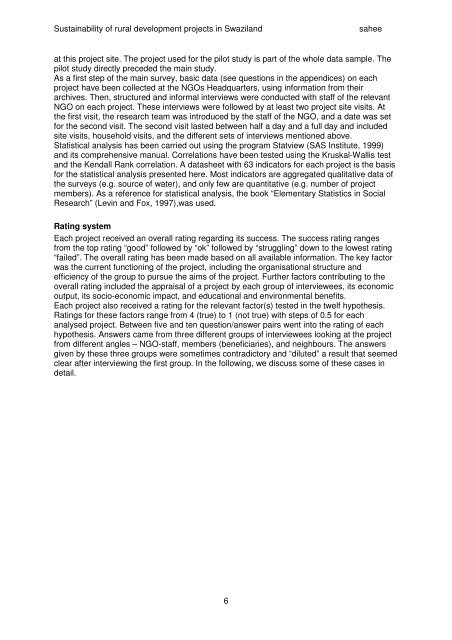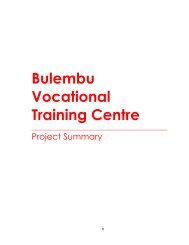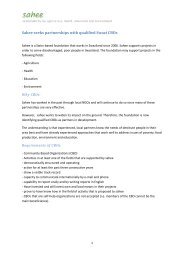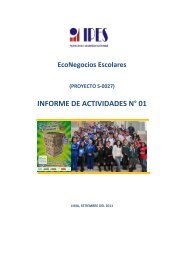Sustainability of rural development projects in ... - sahee foundation
Sustainability of rural development projects in ... - sahee foundation
Sustainability of rural development projects in ... - sahee foundation
You also want an ePaper? Increase the reach of your titles
YUMPU automatically turns print PDFs into web optimized ePapers that Google loves.
<strong>Susta<strong>in</strong>ability</strong> <strong>of</strong> <strong>rural</strong> <strong>development</strong> <strong>projects</strong> <strong>in</strong> Swaziland<br />
<strong>sahee</strong><br />
at this project site. The project used for the pilot study is part <strong>of</strong> the whole data sample. The<br />
pilot study directly preceded the ma<strong>in</strong> study.<br />
As a first step <strong>of</strong> the ma<strong>in</strong> survey, basic data (see questions <strong>in</strong> the appendices) on each<br />
project have been collected at the NGOs Headquarters, us<strong>in</strong>g <strong>in</strong>formation from their<br />
archives. Then, structured and <strong>in</strong>formal <strong>in</strong>terviews were conducted with staff <strong>of</strong> the relevant<br />
NGO on each project. These <strong>in</strong>terviews were followed by at least two project site visits. At<br />
the first visit, the research team was <strong>in</strong>troduced by the staff <strong>of</strong> the NGO, and a date was set<br />
for the second visit. The second visit lasted between half a day and a full day and <strong>in</strong>cluded<br />
site visits, household visits, and the different sets <strong>of</strong> <strong>in</strong>terviews mentioned above.<br />
Statistical analysis has been carried out us<strong>in</strong>g the program Statview (SAS Institute, 1999)<br />
and its comprehensive manual. Correlations have been tested us<strong>in</strong>g the Kruskal-Wallis test<br />
and the Kendall Rank correlation. A datasheet with 63 <strong>in</strong>dicators for each project is the basis<br />
for the statistical analysis presented here. Most <strong>in</strong>dicators are aggregated qualitative data <strong>of</strong><br />
the surveys (e.g. source <strong>of</strong> water), and only few are quantitative (e.g. number <strong>of</strong> project<br />
members). As a reference for statistical analysis, the book “Elementary Statistics <strong>in</strong> Social<br />
Research” (Lev<strong>in</strong> and Fox, 1997),was used.<br />
Rat<strong>in</strong>g system<br />
Each project received an overall rat<strong>in</strong>g regard<strong>in</strong>g its success. The success rat<strong>in</strong>g ranges<br />
from the top rat<strong>in</strong>g “good” followed by “ok” followed by “struggl<strong>in</strong>g” down to the lowest rat<strong>in</strong>g<br />
“failed”. The overall rat<strong>in</strong>g has been made based on all available <strong>in</strong>formation. The key factor<br />
was the current function<strong>in</strong>g <strong>of</strong> the project, <strong>in</strong>clud<strong>in</strong>g the organisational structure and<br />
efficiency <strong>of</strong> the group to pursue the aims <strong>of</strong> the project. Further factors contribut<strong>in</strong>g to the<br />
overall rat<strong>in</strong>g <strong>in</strong>cluded the appraisal <strong>of</strong> a project by each group <strong>of</strong> <strong>in</strong>terviewees, its economic<br />
output, its socio-economic impact, and educational and environmental benefits.<br />
Each project also received a rat<strong>in</strong>g for the relevant factor(s) tested <strong>in</strong> the twelf hypothesis.<br />
Rat<strong>in</strong>gs for these factors range from 4 (true) to 1 (not true) with steps <strong>of</strong> 0.5 for each<br />
analysed project. Between five and ten question/answer pairs went <strong>in</strong>to the rat<strong>in</strong>g <strong>of</strong> each<br />
hypothesis. Answers came from three different groups <strong>of</strong> <strong>in</strong>terviewees look<strong>in</strong>g at the project<br />
from different angles – NGO-staff, members (beneficiaries), and neighbours. The answers<br />
given by these three groups were sometimes contradictory and “diluted” a result that seemed<br />
clear after <strong>in</strong>terview<strong>in</strong>g the first group. In the follow<strong>in</strong>g, we discuss some <strong>of</strong> these cases <strong>in</strong><br />
detail.<br />
6





